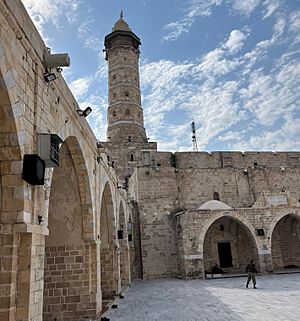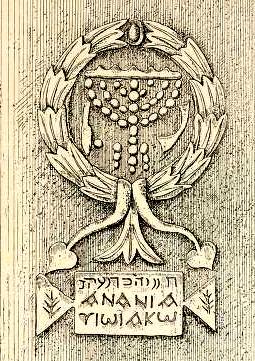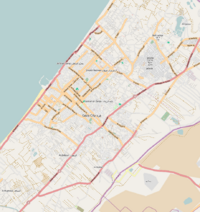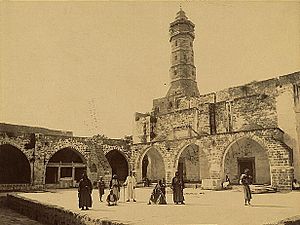Great Mosque of Gaza facts for kids
Quick facts for kids Great Mosque of GazaGreat Omari Mosque |
|
|---|---|

Great Mosque of Gaza in 2022
|
|
| Religion | |
| Affiliation | Islam |
| District | Gaza Governorate |
| Province | Gaza Strip |
| Region | Levant |
| Location | |
| Location | Omar Mukhtar Street, al-Daraj, Gaza Strip |
| Country | State of Palestine |
| Architecture | |
| Architectural type | mosque |
| Architectural style | Mamluk, Italian Gothic |
| Completed | 7th century (original) 1340 (rebuilt) c.1650 (restored) |
| Demolished | Largely destroyed by an Israeli airstrike on December 7, 2023 |
| Specifications | |
| Minaret(s) | 1 |
| Materials | Sandstone (exterior structure), marble and plaster tiles (entrance and interior structure), olive wood |
The Great Mosque of Gaza (Arabic: المسجد غزة الكبير, al-Masjid Ghazza al-Kabīr), also called the Great Omari Mosque (Arabic: المسجد العمري الكبير, al-Masjid al-ʿUmarī al-Kabīr), was the biggest and oldest mosque in the Gaza Strip. It stood in the old part of Gaza.
This important site is believed to have once been an ancient Philistine temple. Later, in the 5th century, the Byzantines built a church there. After the Muslims took control in the 7th century, it became a mosque. An Arab traveler named Ibn Battuta described it as "beautiful" in the 10th century.
Over the centuries, the mosque faced many challenges. Its minaret (tower) fell in an earthquake in 1033. In 1149, Crusaders built a large church on the site. This church was mostly destroyed in 1187. The Mamluks then rebuilt it as a mosque in the early 13th century.
The mosque was destroyed by the Mongols in 1260 but was soon rebuilt. Another earthquake at the end of that century caused more damage. The Ottomans restored it about 300 years later. During World War I, British attacks severely damaged it. The Supreme Muslim Council restored it again in 1925. Sadly, the mosque was heavily damaged in December 2023, with only its minaret remaining mostly intact.
Contents
Where the Great Mosque Was Located
The Great Mosque was found in the Daraj Quarter of Gaza's Old City. It was at the eastern end of Omar Mukhtar Street, southeast of Palestine Square. Gaza's Gold Market was right next to it on the south side. Another mosque, the Katib al-Wilaya Mosque, was to its northeast. A girls' school was located to the east on Wehda Street.
A Look at Its Long History
Ancient Roots: Philistine Temple and Legends
Local stories say that the mosque was built on the spot of an old Philistine temple. This temple was dedicated to Dagon, a god of farming. Legend says that Samson, a famous strong man from the Book of Judges, toppled this temple. Later, another temple for Marnas, a god of rain and grain, was built there. Today, some local legends even claim that Samson is buried under the mosque.
The Byzantine Church Era
In the 5th century AD, a Christian basilica (a large church building) was built on this site. This happened either during the rule of Eastern Roman Empress Aelia Eudocia or Emperor Marcianus. The basilica was finished and even appeared on the 6th-century Madaba Map, an ancient map of the Holy Land.
Early Muslim Mosque: A New Beginning
The Byzantine church became a mosque in the 7th century. This happened after the Rashidun Caliphate conquered Roman Palestine. The mosque is sometimes still called "al-Omari." This name honors Omar ibn al-Khattab, who was the leader during the Muslim conquest.
In 985, during the Abbasid period, an Arab geographer named al-Muqaddasi wrote that the Great Mosque was "beautiful." On December 5, 1033, an earthquake caused the top part of the mosque's minaret to fall.
The Crusader Church Period
In 1149, the Crusaders, who had taken control of Gaza in 1100, built a large church on the ruins of the old one. This was ordered by Baldwin III of Jerusalem. Today, parts of two of the mosque's aisles are believed to have been part of this Crusader church.

Some columns in the mosque have old carvings. One carving showed Jewish symbols like a menorah (a candelabrum), a shofar (a ram's horn), a lulav (palm branch), and an etrog (citron fruit). It also had Hebrew and Greek writing. Experts in the late 1800s thought these columns might have come from a 3rd-century Jewish synagogue in Caesarea Maritima. However, a 6th-century synagogue found near Gaza in the 1960s makes it more likely the column came from a local place. This carving was seen as a sign of "peaceful coexistence" between different groups. Sadly, this carving was removed sometime between 1973 and 1996.
In 1187, the Ayyubids, led by Saladin, took Gaza from the Crusaders and destroyed the church.
The Mamluk Mosque Era
The Mamluks rebuilt the mosque in the 13th century. But in 1260, the Mongols destroyed it again. It was rebuilt, but then an earthquake in 1294 caused it to collapse. Important repairs were made by the governor Sunqur al-Ala'i between 1297 and 1299. Another Mamluk governor, Sanjar al-Jawli, ordered more restoration work between 1311 and 1319.
The Mamluks completely rebuilt the mosque in 1340. In 1355, the Muslim traveler Ibn Battuta visited. He noted that the mosque was "well-built." Inscriptions on the mosque show the names of Mamluk leaders like al-Nasir Muhammad (from 1340) and Qaitbay (from 1498).
The Ottoman Period
In the 16th century, the mosque was restored again after being damaged. The Ottomans, who had ruled Palestine since 1517, ordered its restoration. They also built six other mosques in Gaza. An inscription inside the mosque shows the name of Musa Pasha, an Ottoman governor of Gaza, from 1663.
Some travelers in the late 1800s said the Great Mosque was the only building in Gaza worth seeing for its history or design. During World War I, the mosque was badly damaged by Allied forces attacking Ottoman positions. The British said that Ottoman weapons stored inside the mosque caught fire during the bombing, causing the destruction.
British Mandate Period
After World War I, the mosque was restored in 1926-27. This work was overseen by Said al-Shawa, who was then the mayor of Gaza. The Supreme Muslim Council was in charge of the restoration.
In 1928, the Supreme Muslim Council held a large protest at the Great Mosque. Both local Muslims and Christians joined. They wanted people to boycott elections and not take part in the British government of Mandatory Palestine. To get more people to the rally, they even ordered all mosques in one part of Gaza to close temporarily.
After 1948
The old carvings and Jewish symbols on the columns were intentionally removed sometime between 1987 and 1993. The mosque's structure was severely damaged by attacks during the 2023 Israel–Hamas war.
How the Mosque Was Built
The Great Mosque covered an area of about 4,100 square meters (about 44,132 square feet). Most of it was built from a local type of sandstone called kurkar. The mosque had a large sahn (a courtyard) surrounded by rounded arches. The Mamluks and later the Ottomans made the south and southeast sides of the building bigger.
Above the mosque's door, there was an inscription with the name of Mamluk leader Qalawun. Other inscriptions had the names of leaders like Lajin and Barquq.
Inside the Mosque
When the building changed from a church to a mosque, most of the Crusader parts were replaced. However, the mosque's front, with its arched western entrance, still looked like a Crusader church. Some columns inside the mosque kept their Italian Gothic style. Some columns were even identified as parts of an ancient synagogue, reused in the Crusader era and still part of the mosque.
Inside, the walls were plastered and painted. Marble was used for the western door and a round window (called an oculus) on the western front. The floors were covered with shiny tiles. The columns were also made of marble and had fancy Corinthian tops.
The main central area, called the nave, had a special arched ceiling. Each section was separated by pointed arches. The two side areas of the mosque also had arched ceilings. Ibn Battuta noted that the Great Mosque had a white marble minbar (a pulpit for speeches), which was still there. There was also a small mihrab (a niche showing the direction of prayer) with an inscription from 1663, showing the name of Musa Pasha, an Ottoman governor.
The Minaret
The mosque was famous for its minaret (tower). The bottom half was square, and the top half was eight-sided. This was a common style for Mamluk buildings. The minaret was built from stone from its base up to the hanging balcony. The very top part was mostly made of wood and tiles and was often repaired. A simple dome sat on top of the eight-sided stone part. The minaret stood where the eastern end of the Crusader church used to be. Its three rounded sections were changed to form the base of the minaret.
See also
 In Spanish: Gran Mezquita de Gaza para niños
In Spanish: Gran Mezquita de Gaza para niños
- Sayed al-Hashim Mosque







